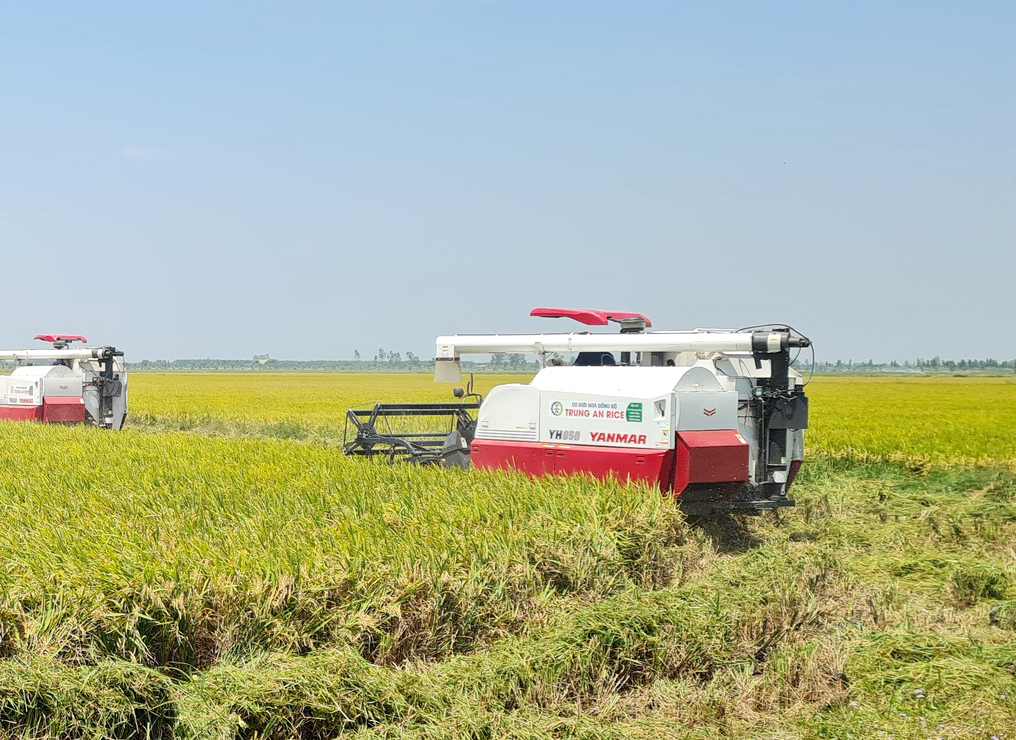November 26, 2025 | 03:50 GMT +7
November 26, 2025 | 03:50 GMT +7
Hotline: 0913.378.918
November 26, 2025 | 03:50 GMT +7
Hotline: 0913.378.918

Rice harvesting in Long An province. Photo: Son Trang.
The Directorate General of Foreign Trade of India recently issued a complete ban on the export of all plain white or non-Basmati rice varieties. Accordingly, India's significant ban came into effect from the signing date of July 20, 2023.
The Indian government has listed several causes for the issuance of this ban. Namely, the retail price of rice in the Indian domestic market has increased by 11.5% within the past twelve months and by 3% compared to the previous month. On the other hand, the total rice production area in India is estimated to have lowered by 6% compared to the same period in 2022 due to unfavorable weather conditions.
The Import - Export Department under the Ministry of Industry and Trade of Vietnam assessed that India's ban on rice exports will affect the global rice trade market because this country accounts for at least 40% of the total global rice exports. India's rice exports reached a record level of 22.2 million tons in 2022. This figure exceeds the total export volume from Thailand, Vietnam, Pakistan, and the United States, which are the four countries that export less rice compared to India. Additionally, nearly half of the total rice export volume, or 10.3 million tons, is made up of the recently banned rice varieties.
Major rice exporting countries around the world are closely monitoring the global rice market in response to India's ban. According to the Bangkok Post, Mr. Chookiat Ophaswongse, honorary president of the Thai Rice Exporters Association, commented that India's ban can potentially raise global prices. Consequently, Thai rice millers and exporters will suspend their orders. In addition, the price of commodity rice in Thailand will increase by 10% as a direct result of this ban.
Immediately following India's ban on the export of non-Basmati rice, the Import - Export Department under the Ministry of Industry and Trade of Vietnam issued an official dispatch to the Vietnam Food Association (VFA) and rice export traders, requesting coordination in stabilizing the consumption of rice, commodity rice, stabilizing domestic rice prices, and ensuring food security.
Namely, the Import - Export Department requested the VFA to encourage major businesses such as Vinafood 1, Vinafood 2, etc. to organize the purchase and consumption of rice, and secure output for rice farmers. Furthermore, the Import - Export Department requested rice exporters to strictly comply with the Government's regulations on rice export businesses, regularly maintain the minimum circulating rice reserve level as prescribed, ensure the balance of export and domestic consumption, and contribute to stabilizing rice and rice prices in the domestic market.
The transaction price of Vietnam's rice exports increased rapidly within the last week. According to the VFA, Vietnamese 5% broken rice was priced at 533 USD per ton, and 25% broken rice was priced 513 USD per ton on July 20. As a result, the prices of all rice exports increased by 25 USD per ton compared to the beginning of July.

Ripe rice from the 2023 summer - autumn crop. Photo: Son Trang.
The price of Vietnamese rice has continuously climbed in recent years, mainly due to the high demand from various countries around the world. On the other hand, the supply of raw rice in the Mekong Delta is currently limited because harvest for the winter-spring rice crop has ended since April, whereas harvest for the summer-autumn rice crop has recently begun in some provinces.
Rice farmers in Long An province, one of the provinces with the largest rice production area in the Mekong Delta, have recently started harvesting the 2023 summer-autumn crop. According to Long An province's Department of Agriculture and Rural Development, Long An province planted 217,164 hectares of rice for the 2023 summer-autmn crop, which is equal to the amount planted in the 2022 summer-autumn crop. So far, multiple summer-autumn rice fields in Tan Thanh, Tan Hung, Vinh Hung, Moc Hoa districts and Kien Tuong town have been harvested for an average yield of 6 tons. The total harvested area is approximately 41,000 hectares, with an expected output of over 271 thousand tons.
According to rice traders, the current limited supply of rice in combination with India's ban on rice export will boost the production of raw rice in Vietnam in the immediate future, affecting the overall export price of rice.
Translated by Nguyen Hai Long
/2025/11/24/3616-2-141832_513.jpg)
(VAN) FSC certification has helped increase the value of thousands of hectares of planted forest timber under the management of the Xuan Loc Protection Forest Management Board, particularly in terms of selling prices.

(VAN) More than 100 shoppers queued for a chance to get a kilo or so of Japanese rice for 500 yen ($3.32) by heaping as much grain into a small wooden box as possible.

(VAN) Benchmark international prices of milled declined in October as harvests started or improved in some parts of the globe.

(VAN) Show cause orders will be issued to retailers who sell imported rice at prices exceeding the maximum suggested retail price (MSRP) of P43 per kilo, Philippines Agriculture Secretary said in a statement on Thursday.

(VAN) Coffee prices on October 20, 2025, remained stable domestically, trading at 113,500–114,500 VND/kg. Similarly, global coffee prices also moved sideways.

(VAN) By October, Vietnam’s coffee exports had surpassed USD 7 billion for the first time and will exceed USD 8 billion within this year.

(VAN) Illinois rancher says Texas, Oklahoma, Kansas lost grass and forage, forcing massive cattle liquidation.